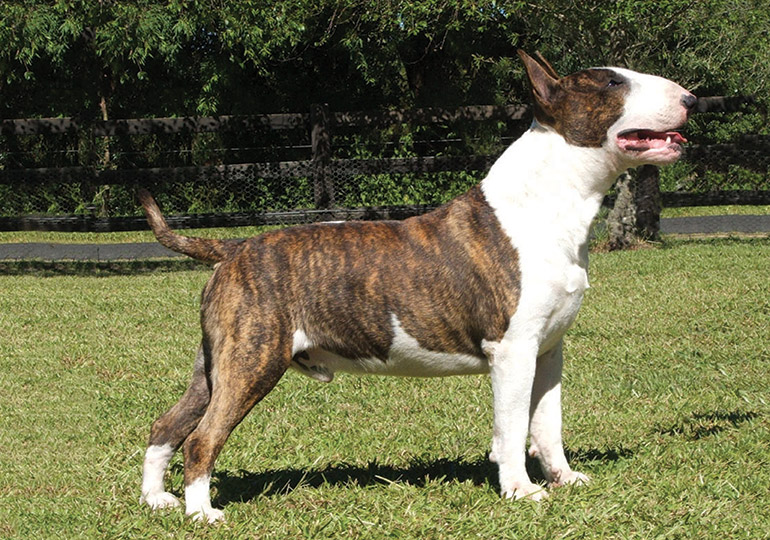Breeds
Bull Terrier

GROUP 2 - TERRIERS
History
The Bull Terrier as we know it today has its origins in England in the early 1800s. The breed was well established as early as 1830 and was mainly the result of crossing the old style Bulldog with several different Terrier breeds. One of the first mentions of the Bull and Terrier in Australia was in the mid 1830’s. There is also mention of an imported Bull Terrier in Queensland in 1852, and in 1862 the first dog show in Australia was held in Hobart with 91 dogs entered including Bull Terriers.
In 1886 several Bull Terriers were imported into Victoria and NSW. With the popularity of the new sport of dog shows, a pure white dog with cleaner lines and longer in head became very fashionable. Colour was introduced by selective breeding to the old-style coloured Bull Terrier.
The first Bull Terrier (Miniature)s were imported into Australia by Wally Webster in the early 1960s. A turning point for the breed was when Lavinia (Busty) Graham- Weall- President of the UK Bull Terrier Club at the time- judged in Australia at the Pal International in 1970. A record entry from across Australia set the breed on a new trajectory.
In 2023 there were three Australian bred dogs competitively exhibited in the Bull Terrier Country Competition in Holland. Recently, an Australian dog was exported to the UK, where he has won 9 Challenge Certificates already, and has just been named Bull Terrier of the Year by the UK Club! This shows how far the breed in Australia has progressed.
Characteristics
It is said that the Bull Terrier is the “Gladiator of the canine race” and possesses great courage. It also must be symmetrical and active as well as amenable to discipline.
Often the clown, Bull Terriers will win your heart with their attention-seeking antics, but loving nature. Many a judge will agree with this assessment when they recall handling Bullies at shows!
A unique feature of the breed is its downward faced, egg-shaped head. The head should be strong and deep, right to the end of the muzzle. Viewed from the front it should be egg-shaped and completely filled. The breed’s profile curves gently, from the top of the skull to the tip of its nose and its eyes should be small, triangular, as dark as possible and give a piercing glint. In fact, the whole dog should be a series of graceful curves- neck into shoulder, slight arching over loin, graceful underline, turn of stifle.
Appearance
Strongly built and muscular, the Bull Terrier is well balanced and active with a keen, determined and intelligent expression. It has been said that the Bull Terrier is an honest dog, as it is difficult to disguise any faults via clever grooming, and the virtues are obvious.
The modern Bull Terrier is a medium-sized dog with no weight or size restrictions according to the breed standard. But in the early days, smaller dogs weighing under 10kg were quite common and have now evolved as the Bull Terrier (Miniature). These two varieties of the breed share a common breed standard with a height recommendation for the Miniature being the only deviation – it should not exceed a height of 35.5cm.
The breed comes in various colours including white, white with head marks, brindle, black brindle, red, tricolour and fawn. In coloured Bull Terriers, colour should predominate. There are no other requirements within the standard regarding colour markings.
Please note that there are NO disqualifications in the breed standard. “Any departure from the foregoing points should be considered a fault and the seriousness with which the fault should be regarded should be in exact proportion to its degree and its effect upon the health and welfare of the dog.”
Health and Maintenance
The Bull Terrier is a relatively healthy breed, but can suffer from deafness, heart and kidney disease and some skin conditions. An eye disease called Primary Lens Luxation was prevalent, but found only in the Bull Terrier (Miniature). In 2009 the gene marker was discovered for the disease; this now allows breeders the opportunity to eradicate the disease using a simple DNA test. Reputable breeders test breeding stock for known health issues.
The Bull Terrier’s coat is short and requires only basic maintenance. If your dog spends a lot of time in the sun, be sure to apply sunscreen. The breed should also be tested for heart and kidney problems. Regular exercise and play sessions will help to prevent destructive behaviour brought on by boredom.
Owners should be aware that the breed has an extremely high threshold for pain and may not always show symptoms of illness. Life expectancy is between 12 and 14 years.
Temperament and Suitability
The breed possesses an even temperament, is highly intelligent, but can also be stubborn. Though some may not believe this, several Bullies have obedience titles! Overall it’s a fun-loving dog that is particularly good with people.
The Bull Terrier is happiest when living with a family and makes a wonderful companion. But as with any breed, care should be taken around small children. When the dogs are younger they are still very powerful and can be quite boisterous.
The breed is equally happy on a rural property as it is in an apartment. It will exercise as much as you want to. The Bull Terrier can be independent minded and stubborn, so should be socialised from an early age.
Words: Christine Craven, Ken Foster, Linda Martin
Image supplied by Tony Wiseman
In Conclusion
Now you know a little about the Bull Terrier, you may think that this is the dog for you. Before you make a decision, please make contact with the breed club or your State controlling body for purebred dogs. They will be able to give you information about available puppies and also suggest dog shows where you can see the breed and speak to breeders. In this way you will gain a better perspective of the Bull Terrier and its needs, and whether this breed would suit your lifestyle.
Breeders




